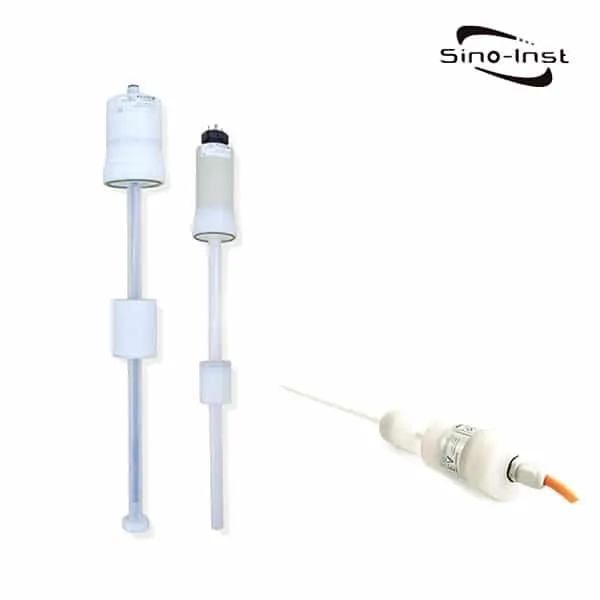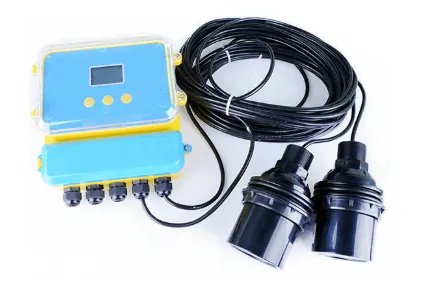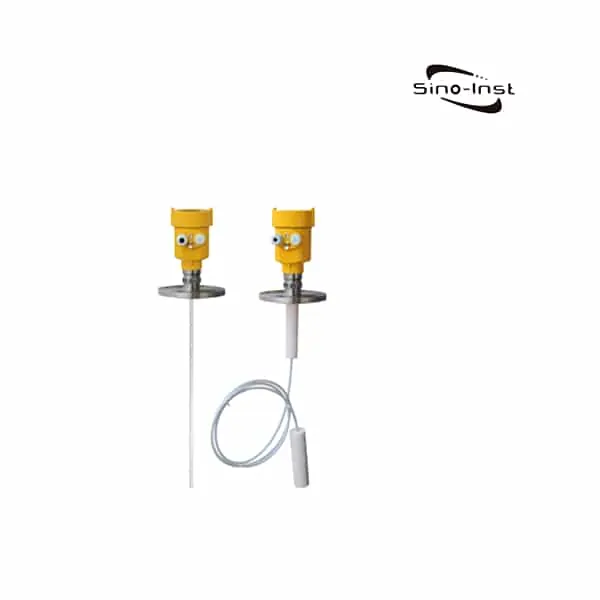Liquid Chemical Level Sensor is suitable for level measurement of corrosive chemicals. Pulse radar non-contact measurement. Antenna made of PTFE.

Liquid Chemical Level Sensor works for level measure and monitor of corrosive liquids for Chemical Processing. The level measurement of corrosive chemicals places extremely high demands on the sensor. Downtime must be avoided. The radar liquid level sensor wrapped in PTFE is corrosion resistant and has a long service life. The sensor has both analog and digital outputs that comply with industry standards. SIRD-901 Radar Corrosive Liquid Chemical Level Sensor is a 26GHz pulse radar level transmitter. The measuring distance can reach 10 meters. The antenna has been further optimized and is suitable for the measurement of various corrosive liquids.
Sino-Inst offers a variety of Radar Corrosive Liquid Chemical Level Sensors for industrial level measurement. If you have any questions, please contact our sales engineers.
Features of SIRD-901 Radar Corrosive Liquid Chemical Level Sensor
The SIRD90 series radar sensor is a 26G Hz radar level measuring instrument, with a maximum distance of up to 80 meters.
- Non-Contact Measurement
- Continuous Level Measurement
- Pulse Radar Measurement Range 0.254 to 15.24m (10″ to 50′)
- Simple Push-Button Calibration
- High measurement accuracy
- Measurement is not affected by temperature, pressure or dust
- User-friendly adjustment saves time
Parameters of SIRD-901 Radar Corrosive Liquid Chemical Level Sensor

| Application: | All kinds of corrosive liquid |
| Measuring Range: | 10 meters |
| Process Connection: | Thread G1½″A / Thread 1½″ NPT / Flange |
| Process Temperature: | -40℃~130℃ |
| Process Pressure: | -0.1~0.3 MPa |
| Accuracy: | ± 5mm |
| Protection Grade: | IP67 |
| Frequency Range: | 26GHz |
| Supply: | 2-wire(DC24V)/ 4-wire(DC24V /AC220V) |
| Signal Output: | 4… 20mA /HART (2-wire / 4-wire)RS485/ Modbus |
| Outer Covering: | Aluminum / Plastic / Stainless steel |
| Explosion-proof Grade: | ExiaⅡC T6 Ga/ Exd ⅡC T6 Gb |
| Antenna Material | Stainless Steel / PTFE |
Applications of Radar Corrosive Liquid Chemical Level Sensor

- Solid materials;
- Process vessels or strong dust are easy to crystallize;
- Condensation occasions
- Solid Particles
- Dust
- Slightly corrosive liquids
- Various corrosive liquids
- Hygienic liquid storage containers
- Strong corrosive containers
Extended reading: Radar Non Contact Water Level Sensor
Corrosive Liquid Chemical Level Sensor in Chemical Processing
Generally, in chemical plants, you will encounter liquid level measurement such as petroleum storage tanks, chemical storage tanks, chemical storage tanks, sewage treatment plants, dosing tanks, seaside, and docks.
Used to measure corrosive media such as sulfuric acid, nitric acid, hydrochloric acid, hydrofluoric acid, sodium hydroxide, and concentrated alkali.
When encountering these corrosive media, corrosive liquid level sensors are generally used. Use non-contact radar level sensors to measure corrosive liquids such as sulfuric acid, hydrochloric acid, and nitric acid.
Following the introduction of Sino-Inst, we have to consider four major principles when choosing a level gauge to measure.


Extended reading: GWR Corrosive Liquid Chemical Level Sensor
The first principle is to consider the principle of non-contact measurement and choose a non-contact liquid level sensor.
Because the probe of the liquid level sensor does not need to contact the medium. The principle of sensing band is used to obtain the current liquid level information. Such a liquid level sensor, for example, when measuring a level, a radar level gauge does not contact the measured medium, and the material used is tetrafluoroethylene. At the same time, it is a fully enclosed anticorrosive structure. Therefore, the effect is very good for liquid level measurement of viscous, corrosive, turbid and other liquids.
The second principle is to consider the convenience of installation.
Due to the uniqueness of the measurement of corrosive liquids such as sulfuric acid, hydrochloric acid, and nitric acid. It needs simple installation on site. It needs to be simple to open a hole in the tank.
Therefore, in the selection process of the level gauge, it is necessary to consider the characteristics of reliable work, easy installation, long service life, and maintenance-free.
The third principle is sensor selection.
When the radar level gauge measures corrosive media, the general manufacturer will choose the anti-corrosion type tetrafluoro material contact surface. Considering environmental factors, a physically sealed anti-corrosion probe should be selected for this occasion.
The fourth principle is the choice of the host part.
As the host part, good sealing is required. As long as there is a little medium leakage, it is possible to enter the inside of the level gauge from the housing or the wire inlet. As a result, the internal circuit board is corroded.
For corrosive gases in the environment, anticorrosive high frequency radar level gauges can be used to protect the service life of the host.
The above is Sino-Inst analyzes how to choose the level sensor for concentrated sulfuric acid and hydrochloric acid. If concentrated sulfuric acid and hydrochloric acid exceed a certain temperature range, steam or vaporization occurs. It is necessary to consider the actual situation on site and re-select the appropriate level sensor.
Extended reading: FMCW Radar Level Transmitter 120GHz
How does a Radar Corrosive Liquid Chemical Level Sensor work?
In radar level measurement, microwaves are transmitted by the antenna system of the radar sensor, to the measured product, reflected by the product surface, and received back by the antenna system.
The time from emission to reception of the signals is proportional to the level in the vessel. In continuous non-contact level measurement with radar, the sensor sends microwave signals towards the medium from above.
The surface of the medium reflects the signals back in the direction of the sensor. Using the received microwave signals, the sensor determines the distance to the product surface and calculates the level from it.
Liquids and solids are commonly measured with this measuring technique.
Extended Reading: Dielectric constant for radar level transmitter
Featured Level Sensors for Chemical Processing
What is the difference between ultrasonic and radar level transmitters?
As the name implies, ultrasonic level sensors, operate by emitting a burst of sound waves in very rapid succession.
These sound waves hit the intended target, bounce back to the sensor, and travel at known speed (the speed of sound). We can calculate the time of flight and come up with a distance.
Radar, by contrast, works not with sound waves, but with electromagnetic waves.
This is the key difference.
Like ultrasonics, the waves bounce off of objects, and travel at a known speed (much faster than ultrasonic waves). But they react differently to certain materials.
There is a different set of variables that affects how well a radar sensor operates.
Unlike ultrasonic sensors, radar is much less affected by temperature, improving consistency and accuracy.
Radar is also well suited for specialty applications, such as working in a vacuum, or in higher pressures (as long as the housing can handle it).
An important factor is the target material’s dielectric constant.
A material with a low dielectric will not reflect an electromagnetic wave, so radar tends to pass right through.
These materials are typically non-conductive and have low moisture content, such as dry powders and granules.
To be fair, radar can sense a lot of these materials, but the energy of the returning waves is so small, that precise alignment with the signal is paramount.
This introduces techniques such as guided wave radar, or special antenna.
Measuring materials with a low dielectric constant, is not always impossible, just very challenging.
All with a low dielectric will not reflect an electromagnetic wave, so radar tends to pass right through.
These materials are typically non-conductive and have low moisture content, such as dry powders and granules.
Extended reading: guided wave radar level sensor advantages and disadvantages
Let’s see this video about: Ultrasonic Level versus Guided Wave Radar Level
Video source: https://www.youtube.com/embed/siAMerrbpPU?rel=0
How do you calibrate radar level transmitter?
- Set up the guided wave radar level transmitter,
- HART communicator, power supply,
- and the multimeter as below (see below calibration setup Diagram).
- Check the configuration of the lower range value (0% level, 4 mA) and high range value (100% level, 20 mA). Make sure that the inputted data is as per the datasheet.
For example, the lower range value is 10 inch and the high range value is 35 inch (both of it are measured from the bottom of level transmitter probe) - Fill the level transmitter chamber with water up to the 0% level. Read the level measurement in the transmitter LCD (or in the HART communicator). Set this condition as 0% level through HART communicator.
- Read the mA output of the transmitter by using a multimeter. Adjust (if any) through the HART communicator so that the output of the transmitter (on the multimeter) is 4 mA.
- Fill the level transmitter chamber with water up to the 100% level. Read the level measurement in the transmitter LCD (or in the HART communicator). Set this condition as 100% level through HART communicator.
- Read the mA output of the transmitter by using a multimeter. Adjust (if any) through the HART communicator so that the output of the transmitter (on the multimeter) is 20 mA.

Frequently
Asked
Questions
More Featured Tank Level Measurement Solutions
Improve Safety and Reliability While Enhancing Efficiency
Extended reading: Drop Antenna Radar Tank Level Sensor
Sino-Inst is Manufacturer of Corrosive Liquid Chemical Level Sensors. We supply more than 20 kinds of Corrosive Liquid Chemical Level Sensors. 70% radar level meters, and other types of flowmeters.
Corrosive Liquid Chemical Level Sensors are mainly used for level measurement of All kinds of corrosive liquid.
With PTFE Antenna Material, SIRD-901 Radar Corrosive Liquid Chemical Level Sensor can measure various highly corrosive liquids and slurries. For example: process reaction storage tanks, acid-base storage tanks, slurry storage tanks, solid storage tanks, small oil tanks, etc.
Corrosive Liquid Chemical Level Sensors enable stable level measurement. This greatly meets the measurement needs of many applications. Can be used from small to large tanks. For efficient non-contact level measurement of Chemical tanks.
Sino-Inst’s Corrosive Liquid Chemical Level Sensors, made in China, Having good Quality, With better price. Our level measurement instruments are widely used in China, India, Pakistan, the US, and other countries.
The entire team at Sino-Inst’s has received excellent training, so we can ensure that every client’s needs are met. For assistance with your product requirements, whether it’s a Corrosive Liquid Chemical Level Sensors, Flow sensor, or other device, give us a call .
Request a Quote

Wu Peng, born in 1980, is a highly respected and accomplished male engineer with extensive experience in the field of automation. With over 20 years of industry experience, Wu has made significant contributions to both academia and engineering projects.
Throughout his career, Wu Peng has participated in numerous national and international engineering projects. Some of his most notable projects include the development of an intelligent control system for oil refineries, the design of a cutting-edge distributed control system for petrochemical plants, and the optimization of control algorithms for natural gas pipelines.








